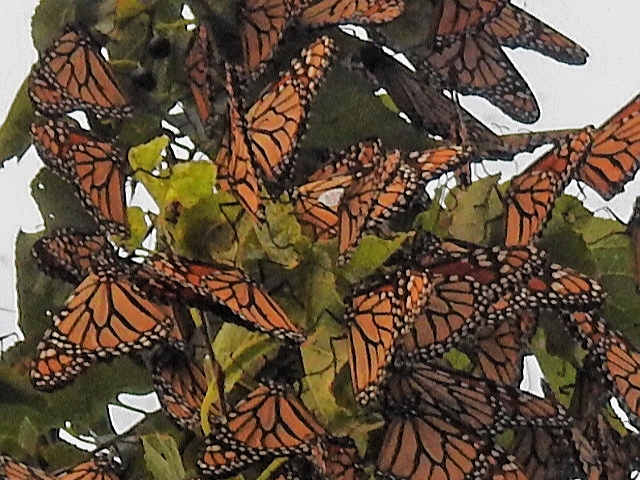
Darlene Burgess died of cancer on April 10, 2024. Darlene was a rarity, a citizen scientist with a truly trinational perspective, and her loss is a big loss for monarch butterfly conservation. She lived near Point Pelee, Canada’s southernmost point where migrating monarchs cluster every fall while awaiting favorable winds to cross Lake Erie. Darlene monitored their overnight roosts and shared these counts widely, both on citizen-science website Journey North and on her own social media. She did this work on a voluntary basis until Parks Canada hired her. In 2019, Darlene participated in the Trinational Monarch Science Meeting in Mexico City, where she met Monarch Watch founder Chip Taylor. Subsequently, she became Canada’s first Monarch Watch conservation specialist.
Darlene was also an honorary board member of Butterflies and Their People, AC, the forest conservation non-profit I founded in an effort to stop illegal logging of the Cerro Pelón Monarch Butterfly Sanctuary. Many conservationists are reluctant to speak out against the Mexican government’s failure to halt the degradation of the monarch’s overwintering sites. Not Darlene. She would often point out the futility of planting milkweed for the monarchs while ignoring the plight of their overwintering grounds: as she loved to say, saving the monarch migration requires trinational cooperation.
In her honor, I’m happy to share this piece from the archives. My interview with Darlene originally appeared in the January 2021 issue of Adopt a Colony, the online magazine I created when our butterfly sanctuary was shuttered during the pandemic.

Raising Butterflies is Not a Conservation Method:
Darlene Burgess on Enjoying Point Pelee, Providing Habitat and the Positive Side of Permits
Ellen Sharp: Why is Point Pelee an important place for the monarch migration?
Darlene Burgess: Point Pelee National Park (or Parc national de la Pointe-Pelée) is a national park that’s in in Essex County in southwestern Ontario, Canada. Point Pelee is Canada’s most southern mainland point, where the land extends into Lake Erie. The word pelée is French for bald; I think it’s neat that the monarchs leave Bald Point to go to Bald Mountain, what Cerro Pelón means in English. The Great Lakes are a significant barrier to the monarchs’ migration. As they move south, they search for shorter ways to cross the lake, and flying from the Pelee peninsula is the closest route across Lake Erie. Point Pelee’s shape funnels the monarchs to its tip. If the weather is cold, they will roost in trees in the park and wait for warmer temperatures and favorable winds to cross the lake. If the weather is warm, they will often go directly across the lake without stopping in the park.
ES: How did you get involved with monitoring there?
DB: We moved in 2010 to our new home, and it’s located on five acres of land just outside of Point Pelee National Park. I call the park our backyard. We left our most southern acre, which is closest to the north end of the Park, natural. It boasts a few species of milkweed (asclepias), the host plant for monarch butterflies, as well as nectar plants such as goldenrod and asters, which are beneficial to all pollinators. At first, we noticed summer monarchs visiting to nectar on our cone flowers and other flowers, and early on we realized that we were in the middle of their fall migration path. During fall migration, I often visited the park near the tip and started photographing and filming roosting monarchs. Park staff became familiar with my passion, and around 2017 they asked me to start monitoring the roosts. Now I conduct an official count of the monarchs that stay overnight every evening before sunset from early September through mid-October.

ES: If people want to visit Point Pelee, when should they come and what should they know about visiting?
DB: Point Pelee is great year-round for hiking, birding, kayaking, skiing and more. To see migrating monarchs, September to mid-October is the best time. The middle of September is usually peak migration, although timing is weather dependent and therefore highly unpredictable. It may take you half a dozen visits before you catch a sizeable concentration of monarchs. They tend to move on cold fronts, and numbers of monarchs in the park will only build when the combination of weather conditions (rain, wind or temperature) prevent them from crossing Lake Erie. If there are resting monarchs near the tip, it’s best to catch them just before sunset or in the early morning. Look for sheltered areas near the tops of trees. Monarchs with closed wings look like dead leaves, so they can be hard to see. A pair of binoculars can come in handy.
ES: When US Fish and Wildlife announced that monarchs merit an endangered species listing but wouldn’t be put on the list yet, many of the folks who raise butterflies in the US were immensely relieved, because they feared that increased federal oversight and regulation would require getting a permit to handle monarchs in the United States. My understanding is that provincial law in Ontario already requires that people apply for permits to rear, handle and tag monarchs. What’s that permit process like, and do you think that increased regulation has dampened anyone’s enthusiasm for monarch conservation in Canada?
DB: The provinces of Ontario and Nova Scotia require permits to handle wildlife, including insects, especially those listed as endangered species. I do not have details on Nova Scotia’s process, but in Ontario it’s free and simple if you apply with an organization such as the Toronto Entomologist Association (TEA). You request as a member to be included on their group permit and the TEA handles all paperwork with Ministry of Natural Resources and Fisheries. You can read more details here. This application process has not dampened anyone’s enthusiasm for monarch conservation in Canada. In fact, I think adhering to these regulations gives monarch enthusiasts more integrity and shows that you are a true advocate for this creature that has been classified in Ontario as a “Species of Special Concern.”

ES: Can you talk about butterfly breeding you have done, when it’s useful, and how your thinking has evolved about what needs to be done to help the monarch migration?
DB: Just to be clear, I’ve done rearing of wild specimens, not breeding. I have never captive bred. People often confuse the two.
ES: What’s the difference between breeding and rearing, then?
DB: Captive breeding is similar to breeding dogs, where a male and female are retained to breed. As the Xerces Society explains it, “captive breeding refers to the practice of keeping adult monarchs in captivity and creating a colony to produce hundreds or thousands of monarchs; some of these are retained for continued captive breeding. It is often a commercial enterprise, with monarchs released at weddings and other events.” Breeding or even smaller scale rearing is not considered a conservation method. Providing habitat is. We must provide them with pesticide-free milkweed host plants and nectar plants to help in increasing their population. Trinationally, both breeding and migrating habitat needs to be maintained and protected, including the forests in Mexico where they overwinter.
These days, I spend more time in my garden and less time than I used to on my outer screened building “rescuing” monarch larvae from predators, although I do relocate some of their insect predators and other milkweed insects to milkweed that I have growing far away from the milkweed the monarchs use. I wild collect mostly fifth instar caterpillars, and let my gardens raise them. I call it “garden rearing.” That means that my focus is on providing and maintaining their habitat needs of milkweed and nectar.
I am not against modest rearing, but I do not condone the collecting and rearing of hundreds and in some cases thousands by some in Ontario. These folks are not complying with the Ontario law of a rearing limit of 100, as mandated by the Ministry of Natural Resources Wildlife Scientific Collectors Authorization. After all, monarch butterflies in Ontario are a “Species of Special Concern,” a category just one step below endangered.



